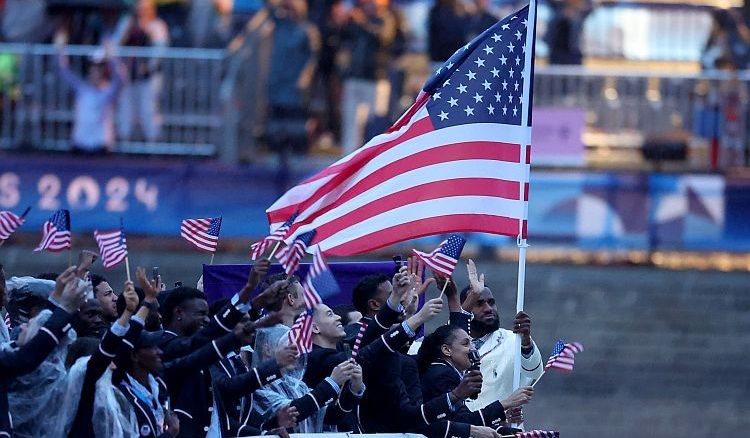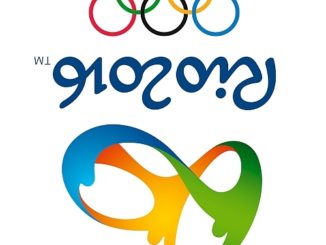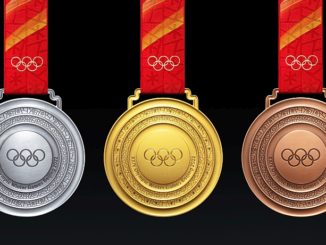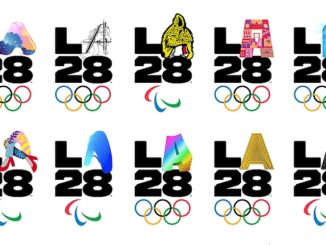
● From our sister site, TheSportsExaminer.com ●
The Games are on. The weather was poor, but the show was great … and safe.
The long-awaited opening of the Games of the XXXIII Olympiad in Paris began with 65-degree temperatures, clouds and increasing summer rain, and the now-obligatory video introduction, with French soccer icon Zinedine Zidane eventually taking torch and running it into Paris, and into the live ceremony.
The concept of using 85 boats to carry the delegations on the Seine across 6 km – and boats of every size, some with one delegation and some with many – allowed the combination of the entertainment elements and the continuing torch relay with the parade.
Lady Gaga performed shortly after the first set of boats passed as part of the 12 “tableau” of the ceremonies, each of which celebrated a specific French theme. The first theme, “Enchante” also included dancers from the Moulin Rouge doing the Cancan, and a masked torchbearer – evoking the story of the “Phantom of the Opera” – crossing the Seine on a zipline and then a direct salute to Paris 2024 sponsor LVMH, whose Louis Vuitton division made the trunks to house the medals and torches.
The parade was held after 41 delegations after the first theme, with the cultural program – themes “Liberte” and “Equality” – taking stage for 25 minutes before the boats resumed.
The Notre Dame Cathedral bell was rung for the first time since the 2019 fire and the “Liberte” segment recognized the French Revolution, with music from the one-time prison, the Conciergerie and a chorus member dressed as Marie Antoinette … and holding her severed head! An impressive pyrotechnic display introduced French pop star Aya Nakamura, who was warmly received.
The “Fraternite” theme started with the masked torchbearer running through the Louvre and works from the museum being raised on the side of the river as an escort on the Seine as the parade continued.
An animated “Despicable Me” segment – produced in France – showcased the continuing masked torchbearer adventure and the 1913 rescue of the Mona Lisa. This led to a solitary – and spectacular – rendition of a re-arranged Le Marseillaise from the roof of the Grand Palais by French mezzo-soprano Axelle Saint-Cirel.
A second rendition of the French anthem was rendered by Saint-Cirel and the 34 members of the Radio France Choir School, which was wildly received by the crowd of perhaps 320,000 on the lower and upper quays of the Seine.
The themes of “Sisterhood,” “Sportsmanship” and “Festivity” brought through all of the delegations except the host country. The last three to enter are the future hosts of the Olympic Games: Australia for 2032, then the U.S. for 2028 and finally, France.
The parade continued past sunset at 9:37 p.m. local time, with just more than a dozen boats in the water, all heavily lit and even more impressive. The U.S. came in on a single barge with its huge team – about 350 attended the ceremony – and then the masked torchbearer was back in action to set up the entry of the French team.
A link to Tahiti showed a welcome from the surfing athletes, getting ready for their competition at Teahupo’o, then back to Paris, where the enormous French barge got a huge welcome from the crowd.
The program moved into a short “Darkness” segment 10 p.m. local time, reflecting a world in conflict, then moved to “Solidarity,” as the last of the boats docked and the athletes moved into seating at the Place du Trocadero, in front of the Eiffel Tower, for the protocol aspects of the program.
(A historical note: the parade of athletes at Rio 2016, the last full Olympic parade as the Tokyo parade was limited due to Covid, took 2:37 and about 2:30 on the Seine in Paris, plus some time to offload everyone. An impressive feat of engineering by the Paris organizers!)
The Olympic flag was brought in on a metal horse “ridden” by Floriane Issert, that powered down the Seine while the national flags paraded into the Place du Trocadero stadium, then transferred to a real horse which Issert rode in, leading the flags of the nations, with athletes on both sides of the Eiffel Tower-shaped runway.
The “Solemnity” segment featured the well-known protocol, with Paris 2024 organizing committee chief Tony Estanguet welcoming the athletes – he was a three-time gold medalist in slalom canoeing – and those who are helping make the Games happen:
“The Games have reminded us that, in France even if we have a hard time agreeing on things, in the moments that count, we can come together and combine all our strengths for a single purpose. …
“Thank you to the 45,000 volunteers. You have come from 155 different countries, from all walks of life: teachers, retired people, nurses, students … and your enthusiasm will light up these Games!”
International Olympic Committee President Thomas Bach (GER) gave his eight-minute address in French and then in English and then back to French, including:
“Our dream is coming true tonight: a reality for everyone to see. Olympians from all over the globe, showing us what greatness we humans are capable of.
“So I invite everybody: dream with us. Like the Olympic athletes, be inspired with the joy that only sport can give us. Let us celebrate this Olympic spirit to live life in peace, as the one and only humankind, united in all our diversity.
“This is why tonight, with my heart full of emotions, I invite the whole world: let us celebrate this joy of sport together with all the athletes. Have faith in the future. Together, let us celebrate the best of our shared humanity.”
After French President Emmanuel Macron formally opened the Games at 10:54 p.m. Paris time, there was one more task to perform.
The finale – “Eternity” – was the lighting of the Olympic cauldron. Zidane appeared in person, bringing the torch into the Trocadero stadium, handing to tennis star Rafael Nodal (ESP) – 14-time winner of the French Open – followed by a light show on the Eiffel Tower.
Then Nadal and the torch were back on the Seine, back in a boat, accompanied by sports immortals Serena Williams, Carl Lewis of the U.S. and Nadia Comaneci (ROU), while another light show took over the Eiffel Tower and a dance performance in the stadium. They handed the torch to French tennis star Amelie Mauresmo, running along the spectators next to the Seine and into the Louvre.
She began a series of hand-offs that reached 17 more athletes, in the Tuileries Gardens.
The final torchbearers were two of France’s greatest: judoka Teddy Riner and triple gold medalist track & field star Marie-Jose Perec. They lit together a giant ring of fire as part of a giant cauldron.
The cauldron itself was an homage to the hydrogen-gas balloon, a French invention, with a ring of fire base of 23 feet in diameter topped by a hot-air balloon of 99 feet high and 72 feet in diameter, which rose majestically in the air in a startling display.
And one more surprise, with Celine Dion performing brilliantly, despite her health challenges, to close the show in stunning fashion.
¶
Was the ceremony a success? Yes it was. Absolutely. The athletes loved being part of something new, something never before attempted, even with the rain.
One of the things that the Seine River parade of nations achieved was no concentrated booing of any delegation, a welcome reprieve from what could have been. Of course, the French barge was rapturously welcomed.
Congratulations to the French security services, national, regional and local, who managed to safeguard what was widely expected to be an almost impossible task.
As a ceremony and as entertainment, what made the opening so astonishing was, ultimately, also the biggest problem.
The Seine-as-stage was too big, too enormous to focus anyone’s attention on either the countries or the cultural elements, some of which were really special. It was a grand, ambitious idea, but too ambitious. These ceremonies are better in stadiums or civic locations where spectators – live and on television – can appreciate one element at a time.
The Seine was novel, but the most moving, most dramatic elements were the stage programs with the torch and Dion’s expected, but moving performance.
LA28 has its ceremony in two stadia, beginning at the Los Angeles Memorial Coliseum and then at SoFi Stadium in Inglewood. Two stages, but one at a time, another new challenge.
Most important, the Paris Games are on. This will be fun.
~ Rich Perelman




Be the first to comment